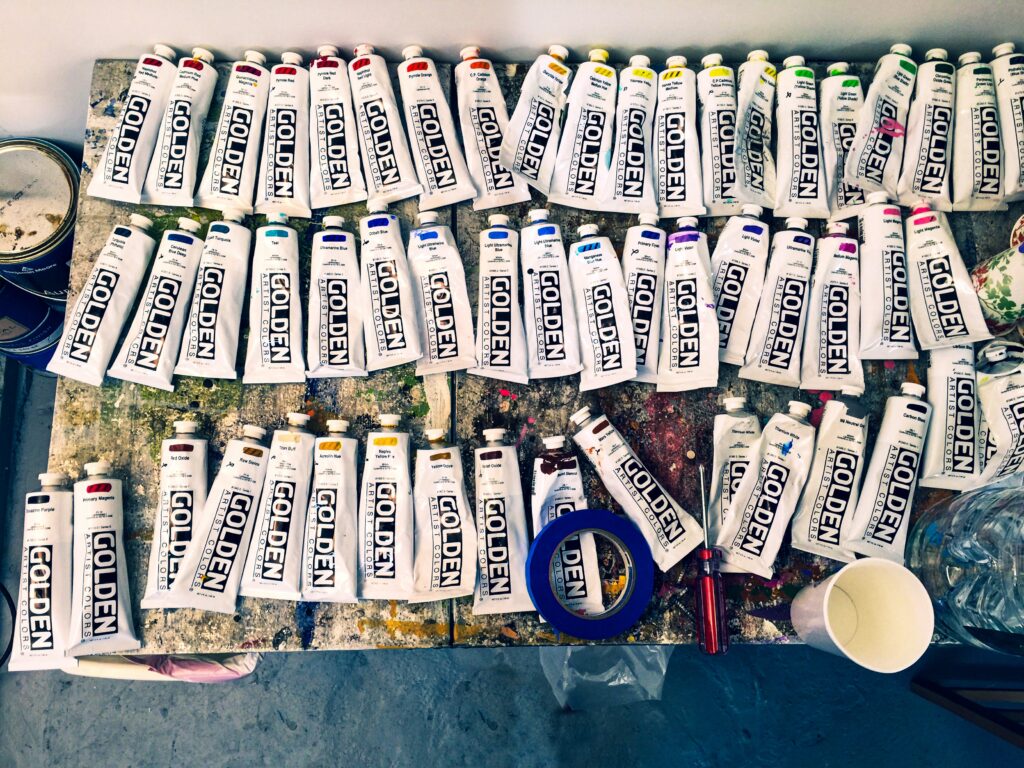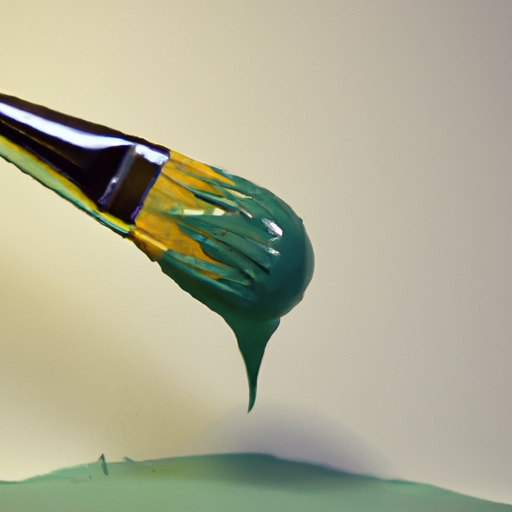Hey there! Ever wondered if acrylic paint can stick to aluminum? Well, you’re in the right place to find out! In this article, we’ll explore whether this popular art medium can adhere to the smooth surface of aluminum. So, if you’re an artist or just someone interested in experimenting with different materials, keep reading to discover the answer to this burning question!

Understanding Acrylic Paint
Acrylic paint is a versatile and widely-used medium that can adhere well to various surfaces, including aluminum. If you’re wondering whether acrylic paint will stick to aluminum, the answer is yes, as long as proper surface preparation and techniques are followed. In this comprehensive article, we’ll take a closer look at the composition and properties of acrylic paint, explore surface preparation steps, discuss the use of adhesion promoters, delve into testing for adhesion, and provide effective bonding techniques. We’ll also consider specific considerations for different types of aluminum surfaces, discuss finishing and protection, explore the applications of acrylic paint on aluminum, and highlight alternative paint options. By the end of this article, you’ll have a solid understanding of how to ensure a strong bond between acrylic paint and aluminum.
Composition of Acrylic Paint
Acrylic paint is made up of pigment particles suspended in an acrylic polymer emulsion. The pigment particles provide the color, while the acrylic polymer emulsion acts as the binder that holds the paint together and allows it to adhere to various surfaces. The emulsion is a water-based mixture that dries to form a durable and flexible film. This composition is what gives acrylic paint its unique properties, making it suitable for a wide range of applications.
Properties of Acrylic Paint
One of the key properties of acrylic paint is its ability to adhere well to different surfaces, including aluminum. This adhesion is due to the film-forming properties of the acrylic polymer emulsion. Additionally, acrylic paint dries relatively quickly, allowing for faster project completion. Once dry, it forms a water-resistant and durable film that can withstand environmental factors such as moisture, UV rays, and temperature fluctuations. Acrylic paint also offers a wide range of colors and can be easily mixed and layered to achieve desired effects.
Surface Preparation
To ensure proper adhesion between acrylic paint and aluminum, it is crucial to prepare the surface adequately. The following steps will help you achieve optimal results.
Clean the Aluminum Surface
Start by thoroughly cleaning the aluminum surface using a mild detergent or degreaser. This will remove any dirt, oil, or contaminants that could interfere with paint adhesion. Rinse the surface with clean water and allow it to dry completely before proceeding to the next step.
Sand the Surface
Next, gently sand the aluminum surface using a fine-grit sandpaper or sanding sponge. This will create a textured surface that promotes better paint adhesion. Be sure to wipe away any dust or debris created during sanding, as they can affect the final finish of the paint.
Apply Primer
Once the surface is clean and sanded, it is recommended to apply a primer specifically formulated for metal surfaces. The primer acts as a bonding agent between the aluminum and the acrylic paint, enhancing adhesion and promoting a smooth and even finish. Follow the manufacturer’s instructions for application and drying time.

Adhesion Promoters
In some cases, especially when dealing with challenging aluminum surfaces, the use of adhesion promoters can further improve the bond between acrylic paint and aluminum. Adhesion promoters are substances that increase the adhesive qualities of the paint, ensuring a stronger and more long-lasting bond.
Benefits of Adhesion Promoters
Using adhesion promoters offers several benefits when it comes to painting aluminum with acrylic paint. Firstly, it enhances the overall adhesion of the paint, thereby reducing the risk of peeling or flaking over time. Adhesion promoters also help to prevent corrosion or oxidation of the underlying aluminum surface, ensuring the longevity of the paint job. Additionally, adhesion promoters can improve the coverage and durability of the paint, leading to a more professional and aesthetically pleasing end result.
Types of Adhesion Promoters
There are different types of adhesion promoters available, each designed for specific surfaces or conditions. Some common types include primer-surfacer adhesion promoters, silane adhesion promoters, and epoxy-based adhesion promoters. Consult with a paint professional or read the product labels to determine the most suitable adhesion promoter for your specific project.
Testing for Adhesion
Before diving into your painting project, it is essential to conduct an adhesion test to ensure that the acrylic paint adheres well to the aluminum surface. This will help you identify any potential issues or areas that may require additional surface preparation or adhesion promoters.
Adhesion Test with Acrylic Paint
To perform an adhesion test, apply a small amount of acrylic paint to an inconspicuous area of the aluminum surface. Allow the paint to dry fully, and then use a crosshatch or tape test to assess the adhesion. For a crosshatch test, make a grid pattern on the painted area using a sharp blade, and then apply adhesive tape firmly over the grid. Quickly peel off the tape, and if the paint remains intact, it indicates good adhesion. If there are signs of peeling or flaking, further surface preparation or use of adhesion promoters may be necessary.
Factors Affecting Adhesion
Several factors can affect the adhesion of acrylic paint to aluminum. These include the cleanliness and texture of the surface, the presence of contaminants or oxidation, the type of primer or adhesion promoter used, and the compatibility of the paint and primer with the aluminum surface. It is crucial to address these factors to ensure a strong and long-lasting bond.
Surface Compatibility
It is worth noting that not all paints and primers are compatible with all types of aluminum surfaces. Certain aluminum alloys or treatments may require specific types of paint or primer. Always check the manufacturer’s recommendations or consult a paint professional to ensure that you choose the appropriate products for your specific aluminum surface.

Effective Bonding Techniques
Achieving a successful bond between acrylic paint and aluminum involves using proper application techniques, selecting the right paint, and allowing for multiple coats and adequate drying time.
Proper Application Techniques
When applying acrylic paint to aluminum, it is essential to follow the manufacturer’s instructions for application. Use a high-quality brush, roller, or airless sprayer for best results. Apply the paint in thin, even coats, allowing sufficient drying time between each coat. Avoid excessive brushing or backtracking, as this can lead to uneven coverage or brush marks.
Choosing the Right Paint
Selecting the right paint is crucial for achieving optimal adhesion and long-lasting results. Choose a high-quality acrylic paint specifically formulated for use on metal surfaces. Look for paints that offer good adhesion and durability, as well as resistance to fading, cracking, or peeling. Read the product labels and consult a paint professional for recommendations based on your specific project requirements.
Multiple Coats and Drying Time
To achieve the desired opacity and a more durable finish, it is often necessary to apply multiple coats of acrylic paint. Allow each coat to dry fully before applying the next. The drying time can vary depending on environmental conditions such as temperature and humidity. It is recommended to consult the paint manufacturer’s instructions for specific drying time guidelines.
Considerations for Specific Aluminum Surfaces
Different types of aluminum surfaces may require specific considerations when it comes to painting with acrylic paint. Let’s explore some common scenarios.
Anodized Aluminum
Anodized aluminum surfaces have been treated with an electrochemical process that creates a durable oxide layer. While acrylic paint can adhere well to anodized aluminum, it is crucial to thoroughly clean the surface and ensure that any oils or residues are removed. Sanding the surface lightly can help improve adhesion. It is also recommended to use a high-quality primer suitable for anodized aluminum surfaces to enhance the bond.
Powder-Coated Aluminum
Powder-coated aluminum surfaces have a layer of dry powder paint applied electrostatically. Acrylic paint can adhere well to powder-coated aluminum, but it is essential to prepare the surface by cleaning it thoroughly and removing any loose or flaking paint. Lightly sanding the surface can promote better adhesion. Use a primer formulated specifically for powder-coated surfaces to ensure optimal bonding.
Raw Aluminum
Raw aluminum surfaces, especially those that are untreated or uncoated, may require more extensive surface preparation to ensure good adhesion with acrylic paint. Start by cleaning the surface thoroughly and removing any oxidation or corrosion using a suitable cleaner or deoxidizer. Sanding the surface and applying a primer designed for raw aluminum will enhance adhesion and promote long-lasting results.

Finishing and Protection
Once you have successfully painted the aluminum surface with acrylic paint, it is important to finish and protect the paint job to ensure its longevity and durability.
Sealing the Painted Aluminum
Sealing the painted aluminum surface with an appropriate clear sealer can help protect the paint from wear, moisture, and UV damage. Choose a clear sealer specifically formulated for use with acrylic paint. Apply the sealer according to the manufacturer’s instructions, and allow it to dry completely before subjecting the surface to any external factors.
Use of Clear Topcoat
In addition to sealing, applying a clear topcoat can provide an extra layer of protection to the painted aluminum surface. A clear topcoat adds an additional barrier against scratches, fading, and environmental damage. Consider using a clear topcoat specifically formulated for use with acrylic paints and metal surfaces for optimal results.
Maintenance and Longevity
To ensure the long-term performance of your painted aluminum surface, it is essential to follow proper maintenance practices. Avoid using abrasive cleaners or harsh chemicals that can damage the paint. Regularly clean the surface with mild soap and water, and inspect for any signs of wear or damage. Touch up any areas as needed to maintain a uniform and protected finish.
Applications of Acrylic Paint on Aluminum
The ability of acrylic paint to adhere well to aluminum opens up a wide range of applications. Here are some common uses:
Decorative and Artistic Projects
Acrylic paint can be used to create stunning artworks and decorative pieces on aluminum surfaces. The versatility and vibrant color range of acrylic paint offer endless possibilities for expressing creativity. Whether it’s painting sculptures, wall art, or personalized home decor, acrylic paint can transform aluminum into a visually pleasing and durable medium.
Industrial and Commercial Uses
Acrylic paint’s adhesion and durability make it suitable for various industrial and commercial applications. It can be used to paint aluminum surfaces on machinery, equipment, signage, architectural elements, and more. Its resistance to environmental factors and ability to withstand heavy use make it a popular choice in industrial and commercial settings.

Alternative Paint Options
While acrylic paint is a reliable choice for painting aluminum, there are alternative paint options to consider, depending on your specific needs and preferences.
Epoxy Paint
Epoxy paint is a two-component paint system that offers excellent adhesion and durability. It forms a hard and resistant surface that is highly resistant to chemicals, abrasion, and moisture. Epoxy paint is often used in industrial or high-traffic areas where extreme durability is required. However, it can be more challenging to work with compared to acrylic paint and may require specialized knowledge and equipment.
Oil-Based Paint
Oil-based paint, also known as enamel paint, has long been used for painting metal surfaces, including aluminum. It offers good adhesion and durability, as well as resistance to wear and environmental factors. Oil-based paint takes longer to dry compared to acrylic paint and requires the use of mineral spirits for clean-up. It also emits strong fumes, so proper ventilation is necessary during application.
Conclusion
In summary, acrylic paint can adhere well to aluminum surfaces when proper surface preparation and techniques are employed. By following the steps outlined in this article, including cleaning and sanding the surface, applying a suitable primer, and using adhesion promoters when necessary, you can ensure a strong and long-lasting bond between acrylic paint and aluminum. Consider the specific type of aluminum surface you are working with, such as anodized, powder-coated, or raw aluminum, and take appropriate measures to enhance adhesion. Finish and protect your painted aluminum surface with clear sealers or topcoats, and practice regular maintenance to prolong its longevity. Acrylic paint offers a wide range of possibilities, from decorative and artistic projects to industrial and commercial applications. Should you need an alternative, epoxy paint and oil-based paint are worth considering. With the knowledge gained from this article, you are well-equipped to successfully paint aluminum with acrylic paint and achieve professional and aesthetically pleasing results.



